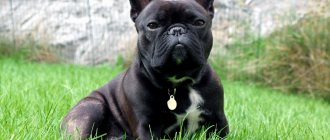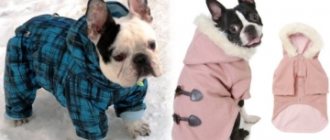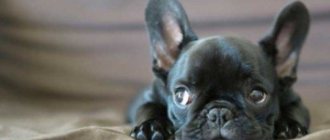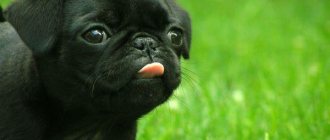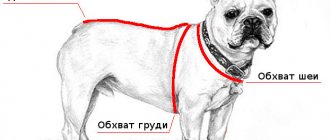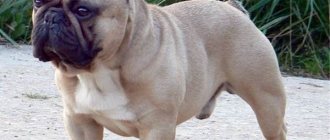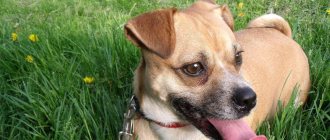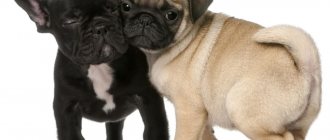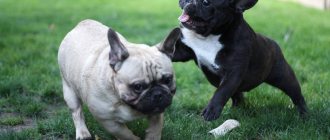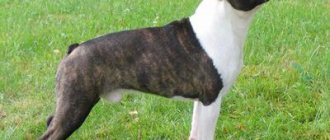To determine how long French bulldogs live, you must first carefully read the standard of this breed. This knowledge will help you understand the pace of a dog’s development: to what age it grows, how much it weighs in a given month of its life, and so on. It is necessary to monitor these parameters, while simultaneously taking into account the anatomical features of the animal’s structure.
Head
The skull of a representative of this breed can indicate many hereditary traits. For example, about the structural features of his body and the strength of his bones. French Bulldogs have several skull shapes:
- ordinary - with a noticeable stop (the transition from the forehead to the muzzle) and a bump on the back of the head;
- heavy – large, powerful, rough, with clearly visible muscles;
- light – narrow, with poorly developed muscles;
- proportional - most suitable for the standard.
The shape of the skull will determine the degree to which the dog belongs to the purebred line of the breed. According to the standard, breeding dogs must have an impressive, square-shaped head. The short part around the nose gives it a wide look. A slightly convex forehead should be clearly visible. The bump on the back of the head is almost invisible.
The skin on the dog's head forms folds. From the lip, between the eyes, there is a furrow that should not extend onto the forehead.
The dog's muzzle is short and quite wide. Its length is one part in six in relation to the head.
The French Bulldog's wide and retracted nose has symmetrical nostrils. They should be open and pointing upward.
The dog's cheeks are drooping and rather thick. The lips are also thick, black in color, and their upper part covers both the teeth and tongue.
The dog's round, slightly convex eyes have a dark tint. They should be low enough and not close to each other relative to the beginning of the ears, due to their large size. The eyelids are black.
In dogs of this breed, ears are one of the main components of their attractive appearance. Therefore, they should be small, set high, with a wide base and rounded ends. The vertically erect ears allow full visibility of the auricle.
According to the standard, representatives of this breed have powerful square jaws. The lower part is slightly in front of the upper and has the shape of an arc. It is desirable that this displacement (undershot) not be too noticeable, but the standard does not particularly monitor this point.
The French Bulldog has strong teeth that should not be damaged in any way. The front teeth of the upper jaw are located behind the front teeth of the lower jaw.
Dogs of this breed have a short neck. It is slightly curved. The standard does not allow any excess fat, folds or loose skin in the area. Ideally, the neck should have well-developed muscles and seven vertebrae, because the mobility of the head depends on these parameters.
Feeding: regimen and features
To accustom a dog to food in a new place, they begin with two bowls: water is poured into one, it stands constantly; food is poured into the other during feeding. Many owners wonder: how many times should food be introduced into their babies’ diets so as not to overfeed them?
Puppies grow especially rapidly in the first three months, so they adhere to a feeding regimen depending on their age:
- 1-2 months – 6 times;
- 2-4 months – 5 times;
- 4-6 months – 4 times;
- 7-12 months – 3 times.
When organizing your puppy’s meals, you should follow the rules: it is forbidden to feed him table scraps and allow him to beg for food. Eating should be done strictly according to the clock and at equal intervals. You should definitely take a break from food at night. This is due to the fact that when overeating, French bulldog puppies experience diarrhea and bloating. Excess weight puts stress on the paws.
Additional feeding is not recommended, no matter how hungry the puppy is. New dishes are carefully introduced into the diet in small portions. It is worth considering that there should not be two unusual products at the same time.
Since it is difficult to balance the diet on your own, it becomes unclear what food is best to feed your pet. Therefore, we will consider the options to choose the most suitable one.
Frame
In French Bulldogs, the withers are formed by the five thoracic vertebrae and the top of the shoulder blades. They are connected by developed muscles.
The wide, well-developed back of the dog, according to the standard, should not sag or, on the contrary, arch. Otherwise, her vertebrae will not be able to withstand physical stress.
The sacrum should be short but wide enough.
The animal's croup should have a slightly rounded shape with a slight slope.
The width of the chest of a French Bulldog directly depends on the location of the ribs - on their curvature. According to the standard, the ideal chest should be barrel-shaped, deep and well developed.
Sometimes dogs of this breed have an anomaly such as the presence of wedge-shaped vertebrae, mainly in the thoracic region. With this disease, the vertebrae do not have a regular rectangular shape, but a trapezoid shape. This can lead to problems with the functioning of the spinal cord. This can lead to paralysis of the limbs.
Note: Males must have properly developed testes that are completely contained in the scrotum.
The dog's small tail should be thick at the base, tapering towards the tip. When excited, the tail should be no higher than the line of the back.
It’s worth moving a little away from the basic parameters of the standard and taking a closer look at this topic. Basically, French bulldog puppies are born with a naturally short tail. This can be explained by genetic predisposition.
But representatives of this breed do not always have such a tail. Some puppies are born with a tail longer than standard. In this case, the breeder must immediately decide whether it is necessary to dock (cut off part of) the puppy’s tail, since this operation is performed when the puppy is three to five days old, no later.
When selling a puppy, the breeder is required to indicate whether he has docked his pet's tail. Especially if it is purchased for breeding, the long tail can be inherited. And even in the case of an exhibition career, a long tail can become an obstacle.
Sometimes surgery is necessary for medical reasons. For example, if a French bulldog's tail begins to grow into its body or it fits so tightly to the body that there is no way to care for the area underneath where diaper rash may appear.
Stages of development of the French Bulldog
As a rule, the entire period of development and formation of a dog is divided into several main stages, during each of which the animal acquires certain life experience.
The feeding process is accompanied by characteristic movements of the puppy's paws, as if pushing away the mother's belly, which helps him suck out more milk.
1st stage (initial)
In French Bulldog puppies, the initial development period lasts from the 1st to the 7th week of their life. Before reaching 2 weeks of age, the baby is practically helpless and completely dependent on the mother.
The main needs of a puppy at this age are eating (mother's milk), prolonged sleep and staying in constant warmth. The sucking reflex is given to the dog from birth, which allows the baby to quickly find the mother's nipple, hold it for a certain time and actively suck milk.
By how energetically a puppy sucks its mother's milk, dog breeders determine its potential vitality, character and degree of activity.
From about the 15th day of life, a bulldog puppy begins to develop visual and auditory perception of the surrounding world. Three-week-old bulldogs can already walk independently, maintain balance, and also consume liquid food as a supplement to mother's milk. At this age, babies still retain a certain dependence on their mother, but do not yet have a social connection with their brothers.
Stage 2 (adaptation)
The puppy adapts to environmental conditions during the first month of life. At this time, the baby is gradually mastering a new world for him. Playing with his mother and other puppies, the little bulldog learns the basics of relationships with his own kind and learns discipline.
In the first weeks of life, the puppy's behavior is based mainly on the innate instincts that he inherited from his mother. Further, the formation of the dog’s character and habits will largely depend on you.
This period is very important for the development of basic conditioned reflexes, because 4-7 week old puppies are very susceptible to all changes in the world around them and they already have a pronounced ability to acquire certain skills.
During the period of adaptation to the environment, it is necessary to carefully observe the behavior of children, noting the most striking manifestations of their character. Adaptation to the external environment is achieved by puppies through auditory, visual, tactile and olfactory contacts with the objects around them.
At this time, the puppy gradually adapts to its mother. The reflex he acquired - to always follow her - will later manifest itself in the owner’s house: the puppy will very quickly get used to following a person. Lethargic, inactive puppies do not adapt well to environmental conditions, and subsequently it will not be easy for them to establish contact with people and relatives.
By the way, sniffing a person is a unique way for a puppy to get to know him. A dog can remember many different people by smell. The number of new acquaintances the puppy makes will determine his future communication abilities.
At the age of 4 to 8 weeks, bulldog babies do not yet experience a sense of fear of strangers, and puppies older than 8 weeks are usually afraid of strangers and hide when meeting them. Therefore, when taking a puppy into the house, the owner must first of all pay attention to his pet’s communication with other people. If this is not done, the dog may grow up either too timid or, on the contrary, too aggressive towards others.
Do not deprive your bulldog of communication with your close friends, relatives, neighbors: remember that your dog’s sociability is the key to its successful upbringing and training.
At 4–6 weeks of age, the puppy is given a nickname, which is chosen at the request of the owner. It may not coincide with the nickname that was assigned to the puppy at the time of its registration in the stud book.
The name of a French bulldog must contain the following vowels - such as A, I, E and Yu. And in no case should the dog's name repeat any human name (Maxim, Sasha, Misha, Olya). As a last resort, names that are rare or not used in our country are acceptable.
Keep in mind that the dog's name should consist of a small number of syllables. The more there are, the longer the bulldog will get used to its name. The nickname must be clearly pronounced, so try to include the following letters: N, L, R, CH, B, V and D. The letters S, W, K, G, P and T are not recommended.
The nickname very quickly becomes an important part of the French Bulldog's personality. That’s why start teaching your puppy to respond to her as quickly as possible. Remember, the longer the name, the more difficult it is for the dog to remember it.
As soon as you bring the puppy home, let him know that he now has his own name to which he should respond. Try to plan the training process so that the dog associates the name with something pleasant, such as food or a walk.
Stage 3 (socialization)
The puppy's socialization stage is the period of its active acquaintance with the outside world. This stage occurs between 8 and 12 weeks of age. At this age, bulldog puppies are very active and curious. Babies treat other living beings with friendly curiosity. They sniff their new acquaintances, and a loud yelp or bark from an animal is just a common reaction to an unfamiliar object.
The puppy is very interested in various sounds: voices coming from a TV or radio, noise arising from the operation of household appliances, telephone calls and other sounds. During this period, your pet gets acquainted with many new phenomena and things: furniture in the apartment, flowers and trees on the street, birds outside the window, perhaps some animals that are in your house (cat, hamster).
French bulldog puppies are very inquisitive
At the age of 8–12 weeks, puppies have increased excitability and an unstable psyche. During this period, they simply need the attentive, sensitive and caring attitude of the owner towards them. We must remember that stressful situations in a puppy can arise not only as a result of overwork, but also, for example, during therapeutic and prophylactic manipulations, vaccination at the veterinarian, etc. Therefore, when going to the veterinary clinic, take some treats with you , to divert your puppy's attention from the procedures that frighten him.
The period of socialization is considered the most suitable for mastering the basics of training. Raising a bulldog begins with the simplest thing - teaching it to be handled. That is, the puppy (and subsequently an adult dog) must allow himself to be calmly picked up, his teeth and ears examined, turned over, placed on the table and on the floor in a stand, and allowed to be done with everything that the owner considers necessary. You should accustom your puppy to such restraint from the first days of his arrival in the house. Believe me: this will make it easier for you to care for him in the future.
At this time, you should also begin teaching your puppy general commands and actively discipline him. At this time, the baby must successfully carry out such commands from the owner as “Place!”, “Walk!” and “Come to me!”, and by the beginning of the 4th month of life, master more complex tasks. Now he can cope with the implementation of those orders and prohibitions of the owner, which are expressed by the commands “Lie down!”, “Sit!”, “Ugh!”, “No!”.
When raising a dog, you need to follow the well-known rule that any extremes are harmful. The owner's boundless love, as well as his excessive severity in communicating with his pet, will not help raise a good dog.
If you handle your bulldog skillfully and patiently, he will become a good and obedient student.
It is very important from the first days of communication with a puppy to let him understand that he must always obey his owner, and try to develop this skill in him even during play. The French Bulldog's charming appearance and good-natured nature often lead to these dogs being overly pampered from childhood. Punishment in this case does not bring much distress to the puppy, and he may become capricious and willful.
Here we must definitely talk about aggressiveness, which can still be present in the behavior of a small puppy and which is often not taken seriously. And this is fundamentally wrong.
The bulldog puppy must be decisively shown from the very beginning that there is subordination in relations with a person. It often happens that the owners only laugh if the puppy growls or tries to bite. Therefore, it may be impossible to distinguish congenital aggressiveness from improper upbringing in an adult dog.
During the period of socialization of your pet, try to accustom him to establishing friendly contacts with other dogs that the owners walk at the same time as you. By enjoying communication with its own kind, the dog grows more balanced, and there are much fewer problems during training.
The French Bulldog is a breed whose breeding and development involved a great deal of work and experience of many people. Take bringing a puppy into your home seriously. Take care of the breed, raise, educate and care for the dog every day, and not from time to time.
It would be useful to remind the puppy’s owner that before the baby reaches 2 months of age, it is inappropriate and even harmful to start training with him, because during training the dog’s psyche is subjected to enormous stress, which can lead to stress.
Stage 4 (dominance)
This stage in the life of puppies occurs around the 12th to 16th week of life, when the struggle for leadership begins between dogs of the same age. The main thing that should happen during this period in the puppy’s psyche is recognition of its owner as a dominant personality, and other family members should also be of higher rank. Otherwise, the dog will pretend to be the leader, and the owner must always remain such.
Practice shows that there are three possible types of relationships between the owner and the dog, which are intensively formed when the puppy reaches 3–4 months of age. In the first case, leadership belongs to the person, in the second - to the bulldog, and in the third, a certain equality of rights is established between them.
At the first opportunity, a growing bulldog will definitely check who is in charge in the family. While playing, he can bite his owner, growl or bark at him. But, each time receiving a worthy rebuff, the puppy begins to recognize the dominant role of the person and learns to obey the owner.
If you want to raise your dog according to all the rules, your personal leadership should be the only acceptable option for you. Therefore, during games and walks, always pay special attention to the dog’s behavior towards you. Contain your pet's curiosity and emotionality, not allowing him to pull you in one direction or the other. Use the “No!” commands. and “Ew!”, lightly slapping the dog on the thigh; Over time, she will learn that it is unacceptable to behave as she pleases with you. A properly trained dog will never bark at its owner, much less bare its teeth and growl at him during play.
Thus, at the dominance stage, a closer psychological contact is established between the dog and its owner. A three-month-old bulldog, when properly raised, fully recognizes the rights of its owner.
During the period of dominance, the puppy already needs systematic training, during which the owner practices the commands “Come to me!”, “Stand!”, “Sit!”, “Lie down!” with him. Physical and mental stress at this age can gradually increase. For a 13-week-old bulldog, you should already purchase a collar and walk him on a leash.
The faster the dog recognizes the leadership of the owner, the more successful the training results will be, and communication with the animal will give you great pleasure.
It is necessary to take into account that by the age of 16 weeks, French bulldogs (especially males) have already completed the formation of their emotional perception of the world around them, and therefore certain skills and attitudes received from you by this time will remain with your dog for life.
5th stage (independence)
This stage of a dog’s psychophysiological development lasts from 4 months to 8 months of age. This is exactly the period when your pet, generally recognizing the leadership of the owner, can allow itself some liberties, trying to demonstrate its independence to the person and thereby showing individuality and realizing the desire for self-affirmation (this is characteristic not only of people, but also of dogs). How can this independence of your bulldog be expressed, which he will not fail to prove to you at the first opportunity?
Most likely, you will be disappointed to watch how your beloved dog, who just yesterday perfectly carried out this or that command, this time seems to not hear it at all and, in defiance, does not at all what is required of it.
In such a situation, you cannot relax and give your pet a chance to become the master of the situation, at least for a while. If you see that your bulldog is being willful, persistently ignoring the tasks received from you, do not follow his lead and persistently demand obedience and complete submission from the dog. Otherwise, your ward will develop an incorrigible habit of doing as he pleases.
Keep in mind that by demonstrating such behavior, the bulldog is trying to win for himself the right to do as he wishes, which, of course, is completely unacceptable for you.
Remember that if you do not pay due attention to the manifestations of its independence, the dog will begin to demonstrate willfulness in any situation, and in the future you will periodically be deprived of the opportunity to manage it and control its behavior.
At the same time, you should not bring down your anger on him and, using brute force, repeat the command in a threatening tone, wanting to achieve its correct execution at all costs. Build your dog's habit of obeying your commands differently: just don't let your bulldog off the leash until you are sure that your pet is perfectly doing everything you want from him.
An owner who indulges the whims and caprices of his dog risks in the future getting an uncontrollable and aggressive animal, loudly barking at every passing car or random passers-by. By showing firmness and persistence in dealing with your ward, you will be able to help him successfully overcome the period of independence and develop the constant habit of strictly following all your commands.
Stage 6 (overcoming fear)
This stage is characterized by the fact that your pet suddenly, without any particular reason, experiences fear of various objects that are already familiar to him and have not previously caused him any negative emotions. At the same time, there is also a fear of new, unfamiliar objects. The owner must help the dog overcome fears of this kind.
This period can last for 1–2 months. It begins, depending on the individual developmental characteristics of the dog, at the age of 6 to 14 months.
You should give the dog the command “Stop!”, then approach the object that causes unreasonable fear in your four-legged friend, and touch the thing that frightens him with your hand. After this, having commanded “Come to me!”, you must wait until your pet also approaches an object that is not at all scary for you (you have already clearly demonstrated this), and makes sure for yourself that this thing does not pose any danger. Behave calmly and confidently, and this condition will immediately be transmitted to your dog.
7th stage (adolescent age)
This stage begins when the bulldog reaches one year of age and continues for 3 years. The dog, as in the period of independence, can make attempts to impose its will on the owner and take a dominant position in the family, as well as among its relatives.
During this period of time, the dog may behave inappropriately even with those to whom it had previously been very friendly and calm. For example, it is capable, completely unexpectedly for its owner, of attacking a fellow tribesman living next door and fighting with him, despite the fact that before both dogs were very friendly with each other and even played together. Friends who come to visit you may also be greeted with a menacing growl or barking right on the threshold, although previously your “Frenchman” treated the same visitors quite friendly.
If the dog is behaving too aggressively and you are unable to control it, you will need the advice of an experienced dog handler: a specialist will help change the situation for the better.
The main thing that is required of the owner during this period is not to lose self-control, perseverance and firmness, but at the same time maintain a good relationship with his stubborn four-legged dog.
Let's assume that some acquaintances come to visit you, to whose visits your pet has long been accustomed, but lately he has clearly not shown them his cordiality. In such a situation, you should not, however, isolate the dog from the people who come to you by locking it in another room. In this case, it is recommended to command the bulldog: “Place!” and give him the opportunity to remain among the arriving guests and feel like a full member of this company. At the same time, warn your friends so that they themselves do not seek to communicate with the dog: let it show its interest in those who come first. In this way, you demonstrate to your pet that you are in complete solidarity with your guests, that you are on their side and they demand respect no less than you do.
The transitional age for a dog is also the period when it reaches puberty. However, this does not mean that the process of physical and mental development of your bulldog has already been completed. Training sessions must remain regular; there is no need to give the dog the opportunity to present its own demands to the owner regarding its rights and responsibilities.
The French bulldog has a number of innate and acquired character traits that are finally formed only by the age of 3 (as a rule, these are instincts associated with the dog’s ability to protect its owner and his property).
Limbs and mobility
The front legs support the entire body of the French Bulldog and are subject to heavy loads. Especially during exercise. Therefore, the limbs should not be close to each other. They should be straight, with well-developed muscles. Developed forearms should be straight and small, shoulder blades and shoulders should be powerful and also small, and elbows should fit snugly to the body.
The dog's compact, slightly rounded paws are slightly turned forward. They have dense pads and tightly spaced toes.
The length of the powerful hind legs is ideally slightly longer than the front legs. They are even and parallel to each other. Powerful thighs should not have round shapes. The hock joints are not particularly angled and are quite close to the ground.
The French Bulldog moves easily and straight, with its limbs moving parallel to its body.
As the dog grows and gains muscle mass, he feels more confident during physical activity.
Where to buy?
Buying a French bulldog today is quite easy. This breed is widespread; puppies are sold both secondhand and in kennels and dog clubs. In the first case, you can take a risk and trust a private person, especially if you want to save money. If you plan to participate in dog shows and breeding, it is better to contact an official breeder.
You need to pay attention to advertisements: if the nursery reports that there are always puppies in stock, this should alert you. Bitches give birth no more than twice a year, most likely an advertisement from a reseller.
Before buying puppies, you need to visit the kennel or the owner and inspect the litter yourself.
Breeders must answer all questions, provide documents, and talk about the conditions under which the dog is kept.
In addition to the droppings, it is also necessary to inspect the French Bulldog's habitat.
It should be clean, dry, light. Responsible owners monitor the condition of the enclosures and ensure compliance with feeding conditions. How puppies are kept will say a lot about their health. You need to pay the breeders only after a puppy has been selected from the litter, and all documents have been shown, checked and completed.
Not all puppies in a litter will be of the same quality. Some correspond more to the breed standards, others less so, so you should not believe that only champions are born from champions.
Dimensions
According to the standard, the weight of a dog of this breed varies from eight to fifteen kilograms, height - from twenty-five to thirty-five centimeters. Since males are slightly larger than females, there is a slight difference in height and weight. The differences between different-sex representatives of the breed can be seen in the table of weight and height of an adult French bulldog:
To find out to what age these animals grow, you need to track how much the dog weighs during its growth. For convenience, all the necessary data is presented in the French Bulldog weight table by month:
As can be seen from this table, standard dogs grow to the age of ten to eleven months. After this, the animal stops gaining weight and begins to grow in width. First comes the growth of the chest and head, as well as muscle mass. French bulldogs reach their final size by the age of one and a half years.
But not all French bulldogs grow and develop according to these data. There is an unofficial variety of mini bulldogs, whose weight is less than the standard minimum of eight kilograms, and accordingly the height of such individuals can be less than twenty-five centimeters. Such dogs are commonly called dwarf French bulldogs.
The lifespan of standard representatives of the breed varies from ten to twelve years. But mini dogs do not fit the standard parameters due to their lack of height and weight. If an animal weighs less than the standard minimum between the ages of eleven months and two years, it is not developing properly compared to normal French Bulldogs.
As a result, mini bulldogs live less, sometimes not reaching the minimum standard age of ten years. The average life expectancy of mini dogs varies from seven to nine years, or even less.
With poor care, a dog's life can be shortened by several years. In general, such animals have not gained in height and weight due to a tendency to various diseases and mental disorders. That is why they need additional conditions throughout all years of life.
How to choose the right French bulldog puppy?
A preliminary study of breed standards will help you choose the right French bulldog puppy. In addition, when choosing a pet, you need to familiarize yourself with the documents, habits and character of the parents of the baby you like, because many traits of this breed are inherited.
In addition, when choosing a puppy, you need to pay attention to its appearance - the baby should be brave, active, playful, well-fed and outwardly healthy. It is advisable to purchase a dog from a specialized kennel with a proven reputation. It is not recommended to take a baby under 8 weeks.
The ideal age for a puppy to move to a new family is 10-12 weeks. By this time, the baby will have already received all the necessary vaccinations and documents.
The price of a purebred puppy with a passport and pedigree will be at least 20,000 rubles. Babies without a pedigree and documents will cost less - from about 3,000 rubles, but there will be no guarantee that the puppy will be purebred and healthy. The price of a dog is also affected by the city where it was purchased: for example, in Moscow the dog will cost more.
Vices
A French Bulldog may be disqualified if it has the following faults:
- multi-colored eyes;
- the nose is not black;
- lip abnormalities;
- scissor bite;
- visible fangs with the mouth closed;
- incorrect ear placement;
- cropped ears or tail;
- dewclaws;
- non-standard coat color;
- absence of a tail.
Does your dog fit the standard standards?
If you liked the article, please share it with your friends.
Puppy development
Breeders calculate the estimated future weight of bulldogs as follows:
- An adult dog will weigh twice its weight at 4 months of age.
- The weight of a small bulldog at 8 weeks is about 25% of its weight in the mature period.
Adult "Frenchies" weigh 8-15 kg, "Frenchies" - 8-12 kg. The maximum height at the withers is 35-37 cm.
Infancy
Newborn bulldog puppies up to 15 days of age. They don’t see or hear anything, but they have sharp claws; to avoid injury, they are carefully trimmed on days 4-6 of life. Babies have developed sucking and feeding reflexes.
Photos and videos of newborn French bulldog puppies:
Milk period
The suckling (milk) period lasts up to 1.5-2 months. On days 10-14, babies' ears open and eyes emerge. At 3 weeks, baby teeth appear.
Primary analyzers and orientation reflexes develop, and excitation processes return to normal. A one-month-old puppy begins to understand his feelings, he wants to explore the world, taste and smell his surroundings.
Photo of a black French bulldog at 1 month:
Video of a French bulldog 1 month:
Photos and videos of a French bulldog 2 months old:
Prepubescent period
The development of puppies up to six months is called pre-pubescent:
- 2-3.5 months. The period of active primary socialization. The bulldog actively explores the surrounding space, its fellow animals, and gets to know people and other animals in the house. The iris of the eyes acquires a permanent color, and at 2 months the ears are fully erect. The dog’s character begins to form: it’s time to educate him and teach him the first commands.
- 3.5-6 months. Milk teeth are replaced by permanent ones. First, the incisors are renewed, then the canines and molars. The permanent dentition is fully formed by 7 months, and by 6 months tubular bones stop growing. There is an active formation of the dog’s character and habits. A very important period for the owner: if you do not train the animal, it will be very difficult to catch up in the future.
At the second stage of the prepubescent period, orientation abilities are enhanced, the dog develops a “caution reflex” and offensive-defensive reactions. When training a bulldog, the owner must take into account that the pet has a poorly developed inhibitory reflex.
